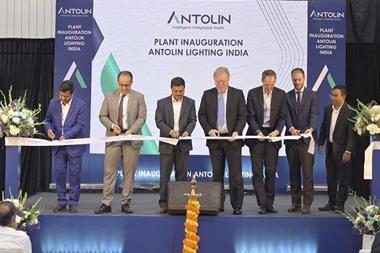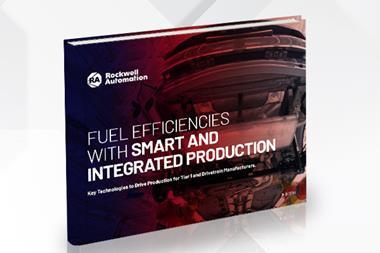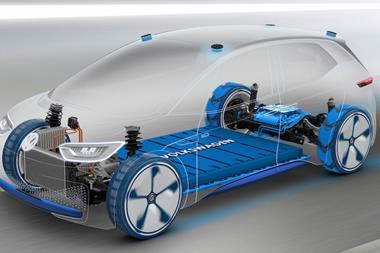A European innovation which has been rolled out at Ford plants in the US

Almost every freshly painted surface on a vehicle will attract airborne contaminants; tiny particles of dust will stick to the wet paint and, as it dries, become part of the surface of the vehicle. Despite their small size, such particles compromise final quality and may become the source of progressive degradation of the integrity of the paint finish, which can result in warranty claims. Yet until recently, the only way to detect the presence of miniscule specks of material has been through the most basic means possible: the human eye.
However, that is now changing – at least at Ford plants. Since the middle of last year, the company has been rolling out a 3D Dirt Detection System which provides a completely automated means of detecting embedded particles “as small as a grain of salt”, in the words of Tom Dougan – project manager, global paint applications for Ford.Dougan is based at Dearborn, Michigan, where the Truck Plant was the first of the company’s production facilities to implement the system as a routine tool, in support of F-Series manufacture.
Since then, the system has also been rolled out at the Valencia Assembly Plant in Spain to support production of C-Max passenger cars and at the Truck Plant in Louisville, Kentucky, for the Expedition and Super Duty vehicles. Ford has embarked on a wider deployment of the system which, by the end of 2013, will operate at three further locations: the Louisville Assembly Plant for the Escape, the Chicago Assembly Plant for the Taurus, Police Interceptor and Explorer and the Oakville Assembly Plant in Ontario, Canada, for the Edge and Flex.
The system is based on a mix of high-resolution digital cameras and specially developed software. As many as 16 cameras – each capable of recording up to 15 images per second – are located around the perimeter of an inspection station and, when a freshly painted vehicle shell arrives, they carry out an automated routine lasting 15 seconds which records over 3,000 separate images of the external surface of the assembly. The cameras are linked to a workstation where the data they collect is collated into a single composite image that can be compared with a reference model from the CAD database generated by the original vehicle design process.
The system displays an image of the assembly to the human operator, with the location and size of any particles that have been detected clearly indicated by means of colour coding. It is then a simple matter for the operator to remove the blemish by a conventional manual polishing operation.
Dougan is confident that the system represents a breakthrough in paint-related quality control, not just for Ford but for the automotive industry as a whole; he says he is unaware of comparable technology anywhere else in the industry. As a consequence, Dougan says that Ford – which owns all the intellectual property associated with the system – had some difficulty finding a supplier which could configure the technology into a workable system. It eventually did so, though the identity of the company remains confidential.
European origins, American implementation
Despite the fact that the system was pioneered as a production support tool in North America, its origins lie elsewhere – in Europe. Dougan says the technology was initially developed by the Institute of Design and Manufacturing, a research organisation in Valencia which works closely with the city’s Technical University.
A first working prototype was achieved in 2010, though Dougan admits that the applicability was limited; it was, he observes, an item of “fixed automation that could handle only one body type”. However, it proved that the concept would work and a low-speed trial implementation followed at Ford’s plant in Genk, Belgium.
It was decided that further development and the first high-speed implementation would take place in North America. According to Dougan, a number of factors were involved in the decision: the company’s internal engineering resources in the US were more appropriate to the task, but so too was the nature of the manufacturing there. Both line speeds and vehicle complexity are appreciably higher in the US than elsewhere in Ford’s worldwide set-up – by as much as 30-40%, according to Dougan, though he concedes that the gap is narrowing. This made it the ideal location to develop and implement the system to meet high-speed industrial requirements.
Processing power & performance
 As for precisely how the system achieves the required performance levels, Dougan is careful not to reveal too much. However, he indicates that the key parameter is the speed with which the system processes large amounts of data. He adds that the computing hardware involved is “considerably more” than a single personal computer, but again he does not reveal details other than to confirm that all the required processing power is housed at the trackside with no need to tap into any remote resources. “The system is completely autonomous,” he states.
As for precisely how the system achieves the required performance levels, Dougan is careful not to reveal too much. However, he indicates that the key parameter is the speed with which the system processes large amounts of data. He adds that the computing hardware involved is “considerably more” than a single personal computer, but again he does not reveal details other than to confirm that all the required processing power is housed at the trackside with no need to tap into any remote resources. “The system is completely autonomous,” he states.
Meanwhile, the front-end of the system is not specialised in any way; Dougan says the cameras are standard, off-the-shelf units of the sort found in many industrial scanning applications.
Nor is there any need for special lighting. The illumination is provided by straightforward fluorescent lamps which produce light in the visible spectrum, though Ford carried out a considerable amount of testing before it finalised its choice of light source. Dougan points out that the intensity of the illumination has to be varied according to the colour of the surface being examined, but apart from that requirement he says the system works equally well with any type of paint or colour.
Dougan is adamant that the system does not replace human operators but enhances their effectiveness. “We have not used the system to reduce staffing levels,” he states. “Instead it means we are better able to exploit their talent.” For a start, the system does not inspect the interiors of the body shells. Nor can it yet provide full coverage of their exteriors; there are still small ‘blind spots’ that have to be inspected by trackside staff, though Dougan says the system can cover at least 90% of the exterior of a body shell and the “theoretical maximum” is 98%.
The system is programmed to indicate to operators which areas of the body shell they still have to inspect, so Dougan emphasises that there is no reason for any contamination to pass unobserved. It also provides a means of prioritising the sequence for removal of the dust particles by flagging up their relative size. Dougan says that a bell curve of the size of particles which can be detected “would centre around two square millimetres.”
According to Dougan, the initial deployment of the technology has focused on commercial rather than passenger vehicles because trucks are complex products which are bought by particularly discerning customers. “It makes them a good place to start,” he notes, adding that “there is never a better place than the factory” to correct perceived faults in a product of any sort.
Dougan observes that this initial roll-out is limited by more than location and vehicle type; at the moment, the technique is being used only as a means of retrospective quality control. As he points out, its true potential as a tool for process improvement through the identification of the sources for contamination is so far unexploited: “This really is just the beginning.”






































